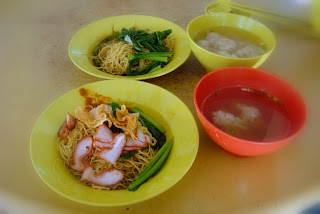 Chai tow kuay
Chai tow kuay ("fried carrot cake" in Teochew or Hokkien) ~ my all time favourite Singapore food. I remember my dad would occasionally
ta-bao ("takeaway") this home for supper if he works late. My brother and I would hold our blunt toothpicks (the old-fashioned kind) and wait anxiously for mum to line the table with newspaper and open the
ta-bao brown paper for us. The big pieces can be easily picked up by the toothpicks but I never liked them, what I liked were the salty, tasty small pieces of kuay and
chai poh (salted radish), which can be quite challenging to pick up with those toothpicks (haha..). Sometimes I would mistaken the garlic as chai poh, but I still liked to try my luck and pick on those tiny pieces cos they had more flavour than the big ones. ^ ^
It never occurred to me that I should ask my dad where he bought it from. But as an adult, I found my favourite
chai tow kuay stall at North Bridge Road Hawker Centre. When I was working in town, Mr Tofu would send me to work every morning. We would drop by this hawker centre for breakfast whenever we had extra time to avoid the ERP. The carrot cake used to taste better, sometimes, the
ah-em would leave the egg a little runny (not sure if it's intentional). But since the stall owners passed their skills to some not-so-young
ah-bengs, it doesn't taste as good as before. Luckily, the ah bengs did not increase the price after they took over, so it still stays at a very low SGD1.50 per plate (you can't get this price anywhere else in Singapore!).
Needless to say, one of the goodies that I
'imported' to Beijing is this packeted carrot cake (for stir-fry) from NTUC! ^ ^
Chai Tow Kuay (Fried Carrot Cake 菜
头粿)
(serves 2)
Ingredients:
1pkt Ready-made carrot cake (cut into cubes)
3cloves Garlic (chopped)
1-2tbsp Chai poh (chopped)
1-2tbsp Oil
1tbsp Fish sauce (use regular soya sauce if you don't have this)
1tsp
Chilli paste (optional)
3nos Egg (or 4 if you like)
2stalks Spring onion (chopped)
Method:
* Fry garlic and chai poh till fragrant
* Add carrot cake and pan-fry till least two faces of it is lightly browned and crispy
* Drizzle fish sauce and chilli paste and stir fry thoroughly
* Spread browned carrot cake evenly apart in pan
* Beat eggs lightly and pour mixture over carrot cake
* Flip carrot cake when egg is almost set (never mind if it's not a perfect flip, it's fun to be imperfect)
* Sprinkle chopped spring onions as a garnish (I ran out of it)
North Bridge Road ah beng's chai tow kuay ~
Now that my 'imported' chai tow kuay is used up, I can only go to Lau Pa Sak restaurant to satisfy my cravings (^ ^)b

Costs abt RMB35-40 per plate.













